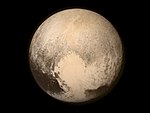astro.wikisort.org - Meteorite
K2-21b, also known as EPIC 206011691 b is an exoplanet orbiting K2-21, a red dwarf 273.5 light-years away from Earth,[3] with a period of 9.3 days.[2][4] It has a density of 2.7g/cm3, indicating that it is not a rocky planet.[2] The margin of error is however quite large, with a possible density between 1.1 and 6.4 g/cm3. Due to this error margin, the true nature of its composition is uncertain.
| Discovery[1] | |
|---|---|
| Discovery site | Kepler Space Observatory |
| Discovery date | 2015 |
Detection method | Transit |
| Orbital characteristics | |
Semi-major axis | 0.0731 AU (10,940,000 km) |
| Eccentricity | null[2] |
Orbital period (sidereal) | 9.32414[2] d |
| Inclination | 88.3+1.3 −1.1[2] |
| Star | K2-21 |
| Physical characteristics | |
Mean radius | 1.59+0.42 −0.44[2] REarth |
| Mass | null[2] MEarth |
Mean density | 2.7+3.7 −1.6 g cm−3 |
| Temperature | 500 K (227 °C; 440 °F) |
References
- Petigura, Erik A.; et al. (2015). "Two Transiting Earth-Size Planets Near Resonance Orbiting a Nearby Cool Star". The Astrophysical Journal. 811 (2): 102. arXiv:1507.08256. Bibcode:2015ApJ...811..102P. doi:10.1088/0004-637X/811/2/102.
- "K2-21 b CONFIRMED PLANET OVERVIEW PAGE". NASA Exoplanet Archive. Retrieved 2015-10-14.
- Brown, A. G. A.; et al. (Gaia collaboration) (August 2018). "Gaia Data Release 2: Summary of the contents and survey properties". Astronomy & Astrophysics. 616. A1. arXiv:1804.09365. Bibcode:2018A&A...616A...1G. doi:10.1051/0004-6361/201833051. Gaia DR2 record for this source at VizieR.
- [dead link]
На других языках
- [en] K2-21b
[ru] K2-21 b
K2-21 b, также EPIC 206011691 b — экзопланета у красного карлика K2-21. Находится на расстоянии примерно 273,5 световых лет от Солнца[2], планета обращается вокруг звезды за 9,3 дня[1][3]. Её плотность около 2,7 г/см3, что указывает на то, что это некаменистая планета[1]. Погрешность плотности, однако, довольно велика, в диапазоне от 1,1 до 6,4 г/см³. Из-за этой погрешности, истинный характер её состава является неопределённым.Текст в блоке "Читать" взят с сайта "Википедия" и доступен по лицензии Creative Commons Attribution-ShareAlike; в отдельных случаях могут действовать дополнительные условия.
Другой контент может иметь иную лицензию. Перед использованием материалов сайта WikiSort.org внимательно изучите правила лицензирования конкретных элементов наполнения сайта.
Другой контент может иметь иную лицензию. Перед использованием материалов сайта WikiSort.org внимательно изучите правила лицензирования конкретных элементов наполнения сайта.
2019-2025
WikiSort.org - проект по пересортировке и дополнению контента Википедии
WikiSort.org - проект по пересортировке и дополнению контента Википедии


